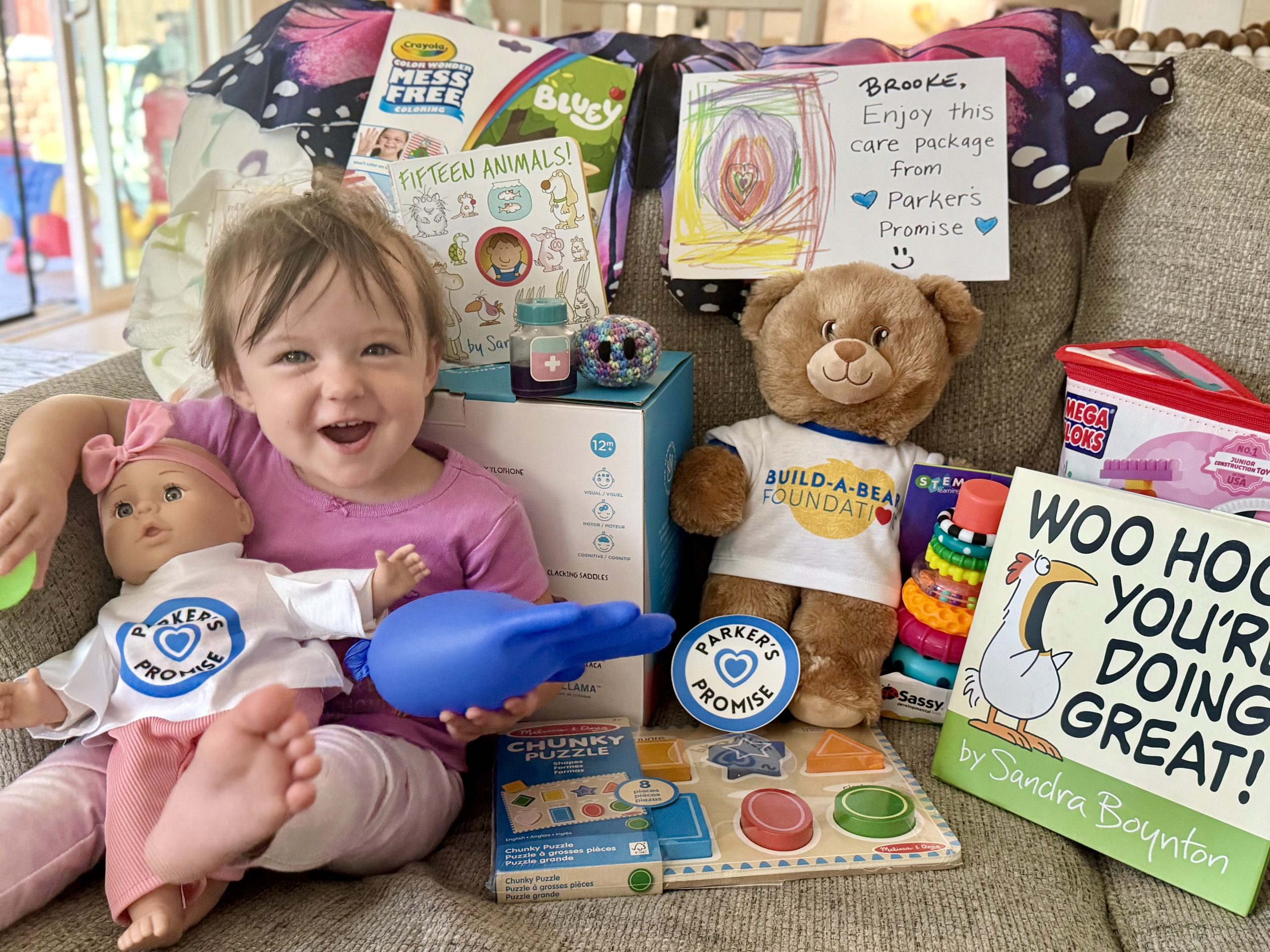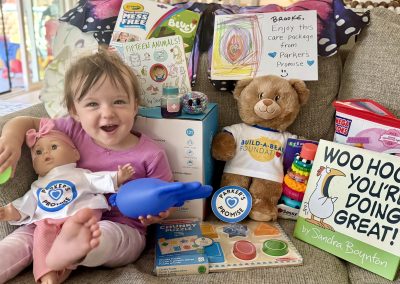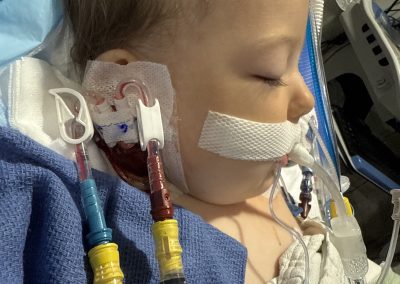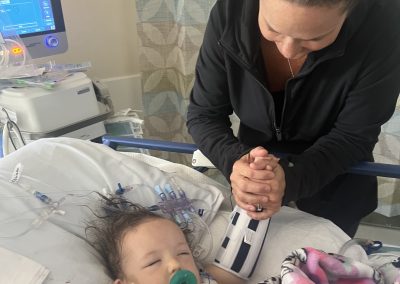Brooklyn M’s Story
June of 2025
Age: 17 months
Location: California
Source: Goat Milk
Infection: Shiga toxin-producing E.coli (STEC)
Disease: Hemolytic Uremic Syndrome (HUS)
Days Hospitalized: 11
Days of Dialysis: 5

I kissed my daughter goodbye thinking I might never see her alive again. Hour after hour was
spent unconsciously preparing and suppressing the possibility that we’d have to plan a
funeral for our baby. We were living in a nightmare.
Until June 4th when the nightmare officially began, our baby Brooklyn was a happy, active 17-
month-old toddler. Full of personality. Always quick to love, especially when it came to her
big brother, Devin (16), and older sister, Alana (4).
We have always made healthy choices when it comes to what we feed our children and
ourselves. We constantly sought out healthy solutions to help them not only feel healthy and
strong, but to improve their overall immune systems too. We’ve been very deliberate about
minimizing toxic or unhealthy choices, especially in regard to what foods are in our home,
what we cook with, and what we put on our bodies.
When Brooklyn became deathly ill due to E. coli O157:H7 from raw goat milk, it opened our
eyes to a brand-new horror of which we’d been surprisingly unaware.
Our nightmare began around the weekend of May 31, 2025. My wife, Emily, had injured her
back and was in pain, so I spent the weekend with our girls to give her time to rest in bed and
reset. At the time, Brooklyn’s diapers looked slightly off. I wasn’t alarmed but I did make note
of it in my mind.
By Monday, June 2, everything started to unravel. That morning, Emily took the girls to their
usual swim lessons and afterward, while driving home, Brooklyn threw up suddenly and
violently in the car.
Emily called me in a panic, and I rushed home to help. As Brooklyn continued to throw up
throughout the afternoon, Emily was in contact with our family doctor. Lots of photos and
texts kept Brooklyn closely monitored. Early signs leaned toward it being a typical stomach
bug, and we were instructed to keep her fluids up and monitor her closely.
The next morning, though, she vomited yellow bile. Then again. It continued throughout the
day and Brookie became increasingly lethargic. She still drank small amounts of water and
breastmilk and sucked on a Pedialyte popsicle. Still, it had only been less than 30 hours since
she first threw up and we concurred with our doctor to “see how she does overnight”. We all
still thought it was a run of the mill stomach bug.
On Wednesday morning, I went to my work office at the usual 7 a.m. time. I was on a
conference call when I received a text message from Emily that included an image of yellow,
and then blue/green bile thrown up from Brooklyn. I immediately notified the guys on the call
that I had to leave and take our daughter to the doctor.
By 11 a.m., we were with our family doctor, and he immediately noticed that something was
very wrong. Brooklyn was not responsive to touch like he typically expected during an
examination, but she was lethargic and limp when held. He sent us right to the ER with a
written note stressing the seriousness of her condition, asking for IV fluids for dehydration
and an abdominal ultrasound.
At the hospital, they ran imaging and found no obstructions. They almost sent us home with
instructions to keep her hydrated because she “didn’t look that bad,” but because our family
doctor made the recommendation in writing, we insisted they give her IV fluids right then.
Because of this, they also decided to do bloodwork since they could use the IV line for the
blood draw too. If we’d have gone home, no bloodwork would have been done, and she
wouldn’t have lived through the night. That note from our doctor literally saved her life that
day.
After 30 minutes on the IV fluids, a result from the bloodwork came back: Brooklyn was
severely anemic. Then, fifteen minutes later, another update: markers for a condition called
Hemolytic Uremic Syndrome (HUS). Everything changed in an instant! We’d never heard of
HUS, so we started doing searches online. It was rare. It was dangerous. And it was horrifying.
It is often caused by a strain of E. coli, and because of that Brooklyn would need to be
transferred to Rady Children’s Hospital in San Diego, 67 miles away.
They told us they’d been in touch with Rady Children’s and Brooklyn would be transported to
the PICU there by ambulance. Thankfully, we thought, Emily would be riding along too, but
then Brooklyn was in the back and Emily was unable to see or touch her. The hour and a half
ride down there was torture for my wife being so close to our baby but not able to hold and
comfort her. Meanwhile, I had to rush home and pack some clothes for everybody in
anticipation of a few nights in a hotel in San Diego. While waiting for the transfer, the hits
just kept on coming … there were indications of kidney injury, so they told us to prepare
ourselves for the very real possibility that Brookie would have to be put on dialysis. By 6:30
p.m., when we’d been fully admitted to the Pediatric ICU at Rady Children’s Hospital,
Brooklyn’s condition had seriously deteriorated, and every minute was becoming critical.
As I was driving down with Devin and Alana in the car with me, Emily called from the room,
full of doctors. They said, “We may need to start dialysis but in order to do this Brooklyn
would need to be sedated so we can place the necessary lines required.” Meaning, she’d have
to be intubated and put on a ventilator. Life support. This got very serious, very fast. We
asked about the risks and whether this was a “must” or a “maybe”. I was still 45 minutes
away, but because it was a “maybe” we agreed to make the decision after I checked into the
hotel, got the kids settled and arrived at the hospital.
By the time I got to Brooklyn’s room, dialysis was no longer an option. She was in renal failure
and barely conscious as her body was shutting down. The medical staff needed to act fast so
we could not be in the room while they worked … we barely had two minutes to have what
we feared was our final moments with our sweet girl. I kissed her, stroked her hair, and
whispered in her ear, “Daddy’s here. You’re so strong. We love you. Please come back to us!”
What was supposed to be a 2-hour procedure took nearly 7 hours. Her body, tiny and
inflamed, resisted every attempt, as her veins kept clotting. Emily and I sat in the waiting
room alone, in agony, as the minutes dragged by. Emily was terrified and imagining the worst.
I felt a chill and inconsolable, and every time someone came in the door, I held my breath.
Finally, around 5 o’clock Thursday morning, we were allowed to see her. She was pale and
motionless. Hooked up to machines, she looked like a shell.
We held her little hand and Emily told her, “Mommy and daddy are here.” Despite being
under heavy sedation and on life support, tears streamed out of her eyes and down her
cheeks. She knew we were there. And we knew she was there too! Dialysis started an hour or
so later.
After two days of dialysis treatments (Thursday and Friday) she’d had multiple blood and
platelet transfusions. Doctors wanted to take Brooklyn off the ventilator and wake her up
saying this would be better for her body to recover. At 3:30 p.m. Friday, I sent my dad a
picture of Brooklyn, now off the ventilator but not awake. Doctors expected it to take up to
an hour or so for the sedation to wear off, but she wasn’t waking up.
Her eyelids would flicker open, but her eyes would roll back, and we could only see the whites
of her eyes. After a CT scan we knew there wasn’t any potential sign of stroke. Several hours
after she’d been off all sedation drugs she was twitching and almost convulsing and seemed to
be trying to open her eyes, but she wasn’t responding to some basic pain tests like the doctors
expected. “Come on Brookie, we need you to wake up.” We felt helpless. This wasn’t
supposed to be happening to our little baby girl.
Due to high levels of acid in Brooklyn’s blood, her breathing was rapid, indicating her lungs
were working overtime to remove the CO2 from her body. Concerned with brain swelling and
possible brain damage they ordered two non-invasive tests – an EEG and a brain MRI.
Brooklyn was scheduled for the brain MRI the next morning, June 7 th . Bloodwork had shown
that she had streptococcal pneumoniae, which is treated with antibiotics. The HUS she had
was very likely caused by Shiga toxin-producing E. coli (STEC). Antibiotics are contraindicated
for STEC infections, and their use can increase complications making the HUS worse, but they
felt they needed to treat the streptococcal pneumonia and started the antibiotics.
They really needed to know the cause and the only way to test for E. coli is from a stool
sample. Brooklyn had not peed or pooped since being admitted to the PICU, so while the MRI
scan was happening, I drove home to collect some recent diapers to bring back to the hospital
so they could test Brooklyn’s stool.
While at the house, Emily called, again with a room full of doctors. The MRI scan had cleared
Brooklyn of any stroke or blood clots, however now they had other concerns. The phone call
ended with a confirmed plan for doing a lumbar puncture to test for meningitis. I finished up
at home, getting what was needed. Devin and Alana were with me, so we started the hour-
plus drive back to the hospital.
We were now basically living at the Ronald McDonald House across the road. Emily had the
only room key, so I parked and left the kids in the car while I ran up to the PICU room to get
the key. When I got to Brooklyn’s room, Emily handed me the key and softly said, “Things
have changed.”
Immediately looking at Brookie, she was sitting up slightly with her eyes more open, but
seemingly not alert. She looked much worse than earlier in the day, before the MRI.
Something was really wrong. Her eyes were open, but vacant, and her face was slack. It was
like her soul had left her body. I felt like time slowed down.
The walk across the road to get the kids into the room and come back to the hospital took
about 15 minutes. I couldn’t say anything to them because I didn’t know what had happened
yet, and I wanted to protect them as long as I could. But I knew it was something bad.
Thoughts flooded my head of a brain injury, a stroke, seizure, or something. I feared my
Brooklyn was no longer there, that her body was somehow still alive but her personality,
memory, and ability to move, were gone forever. “No matter what,” I said to myself, “I will
take Brookie alive over the alternative.” I needed to be strong for my wife and be her rock to
deal with whatever she was about to tell me. I sucked it up and prepared for the worst.
Then I was delivered the news: Brooklyn had suffered three ventricular tachycardia (V-tach)
events. One was earlier in the day and was minor, so we hadn’t been told about it, but the
other two were shortly after our earlier phone call when I was at home. The worst one was
around 2:30 pm and Emily was in the room and saw the entire thing. It has changed her in
ways I can’t describe. That was her hardest moment of everything; to see her baby go into
cardiac arrest was terrifying. To ensure our safety for the drive back to the hospital, the
doctors advised Emily not to tell me what had happened until I was there in person.
Doctors explained V-tach as “cardiac arrest with a pulse.” When the 2nd “big” cardiac arrest
happened; they gave her lidocaine to stabilize her heartbeat. Her blood was so acidic that it
caused the electrical signals in her heart to malfunction. If she hadn’t already been in the ICU
she would have died. The realization hit me like a ton of bricks – We almost lost Brooklyn
today …
Doctors had put Brooklyn on constant dialysis. We could now see clearly that the future for
Brooklyn was completely uncertain. We feared another cardiac event. We had no idea how
long it would take for Brooklyn to recover, or whether she would even fully recover. And to
this day, we still don’t know what the long-term effect of this ordeal is going to be for
Brooklyn, not to mention the rest of our family.
Saturday, the 7 th of June was such a long day with so many hard pivots and wrenching curves.
Fortunately, though we didn’t know it then, this is where our story started to turn the corner
and the healing had begun. Around 7:12 p.m. Brooklyn started to open her eyes. She began to
regain consciousness and … finally, amazingly … recognized us.
It was confirmed the next morning that she had E. coli O157:H7 and they stopped all antibiotics.
She started continuous renal replacement therapy or CRRT, which is a type of dialysis used in
intensive care units to support patients with kidney failure. It’s essentially an artificial kidney
that filters waste, toxins, and excess fluid from the blood when the patient’s own kidneys are
not functioning properly. At 5:58 a.m., Brooklyn cried for the first time in four days. Her voice
was so very small and weak but thank God we got to hear her tiny cry!
By noon, Emily, after nearly a week, was able to hold her and Brookie got to breastfeed. By
June 9 th , as CRRT continued, Brooklyn got off supplemental oxygen. While sleeping her heart
rate dropped very low (bradycardia), so they gave her an EKG. By this point, she had discovered
her central line and hemodialysis line. She thrashed a lot, and they had to restrain her little
hands, so she didn’t roll over and accidentally pull her central and hemodialysis lines out –
because they both went directly into her heart.
The next day she was back on oxygen. The CRRT continued. She had high blood pressure that
was being closely monitored along with her blood gases. By Saturday (June 11 th) she’d begun
eating just a little bit and produced urine. Her bright little personality was beginning to shine
again! There were still concerns for bradycardia, but she was still being monitored 24/7 in the
PICU by two dedicated nurses.
On June 12 th we were transferred out of the PICU to a regular floor. (We were scared and very
hesitant to leave the PICU!!) Brookie finally ate a meal close to 11pm. She kept improving and
the next day Emily and Brooke even got to play on the floor with some toys and without all the
leads connected to her. Mommy and baby even took a nap together, cuddling on the floor mat.
I think this was the first time my wife felt like her baby was back.
On the 14 th I got to spend most of the day with Brookie, so that Emily could finally get some
sleep. We had been taking turns staying in the room with Brooke because on the “normal floor”
there isn’t a nurse right there with her 24/7 and both of us were terrified she’d have another
cardiac event, or something would happen. Neither of us really slept at all. We literally didn’t
know how we could maintain like this.
The very next day was Father’s Day, and I was given the best gift ever – I called Emily who had
finally gone back to Ronald McDonald House to sleep for a few hours, and told her the good
news, “They say we can go home!!” Instantly, Emily said, “Nope! No way!” She was too scared
to leave. I was too scared to leave. We were all a little shellshocked and not quite ready to trust
to hope. It took a lot of convincing from the nephrologist, cardiologist, and new friends from
Parker’s Promise (HUS support group) to convince us that it is OK to go home.
Throughout the whole experience I felt paralyzed. I couldn’t help my daughter. I couldn’t
protect her. I feared we were preparing for a funeral. I had terrible visions of writing her
obituary. There was no coping. Just survival. We were holding Brookie’s hand, brushing her
hair, whispering to her that we were there. This was really all we could do.
Once we were moved to the general floor, there were no longer two nurses watching Brooklyn
round the clock. Emily and I started trading off bedside shifts, so Brooklyn was never left alone.
We couldn’t even grieve together. We couldn’t show up for each other because we were each
just trying to survive emotionally. We were barely holding on. Devin, our teenage son, was
thrown into a caretaker role for his younger sister. And Alana could see that we were so scared,
and Brooklyn wasn’t there, but she didn’t fully understand what was going on. It was torturous,
all the scenarios we imagined, breaking the news to the two older children. We tried to prepare
for a life without her but just couldn’t do it.
The idea that this all started because of goat’s milk we’d been giving Brooklyn daily, thinking
it was healthy, is unbearable. We are living through a nightmare that no family should
endure. This kind of trauma doesn’t simply go away. The farmer ensured us the milk was from
a “clean and tested herd” however upon being informed of our daughter’s E. coli infection,
the “farmer’s” responses made it clear that she was not testing, probably never had
tested anything, and did not even know how to test for E. coli.
This wasn’t a mistake we could have seen coming. It wasn’t bad luck. We feel lied to and
betrayed. Yet this person continues to sell the milk, skirting the laws by labeling her milk “for
pet consumption only” but openly still selling it to people who have made it clear they want it
for human consumption. The E. coli was never addressed, never dealt with, and she continues
selling it as if our daughter’s life doesn’t matter. You thought our daughter’s life and health
was worth the gamble. You need to understand this: we almost buried our daughter.
Brooklyn survived, but she is not the same. We are not the same. This is not over for us. It’s
only just begun. And now, every day we wake up grateful that she’s alive, but terrified of
what comes next. Will Brooklyn need a kidney transplant? Will her blood pressure always be
dangerously high? Will her heart fully recover? What’s the cost, emotionally and physically, to
monitor her health for the next 17 years? What should we feed our children? What about the
next fever, the next “stomach bug” or the next time something seems “off”? How are we
going to pay for everything?
Doctors said she would’ve died had we chosen to go home from the ER that first day. She now
has routine bloodwork and nephrology appointments because her kidneys were so
injured. She’ll need lifelong monitoring: first weekly labs, then monthly, then annually until
she’s 18 years old.
On the one hand … Our view of the world has shifted. Our sense of safety has been stripped
away. Food feels unsafe. We no longer trust what we buy. We’re terrified to give our kids
food that hasn’t been cooked or cleaned by ourselves.
On the other hand, … Brooklyn is happy to be home and thriving despite still having high
blood pressure and being on BP meds. Though her electrolytes and creatinine are still off, her
platelets and hemoglobin are finally close to normal levels. We came home broken, but we’re
figuring out how to put it back together again. Wiser. Stronger. Healthier. More resilient.
We are anticipating a long journey but thank God, we have her, and she survived the worst of
it. She’s a tough little fighter and it’s a miracle she’s alive.





